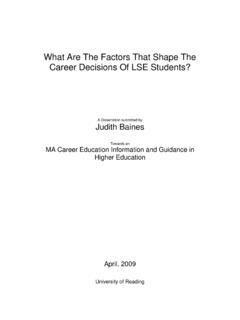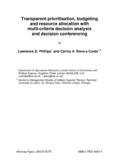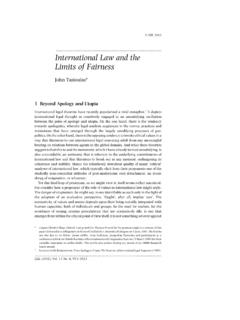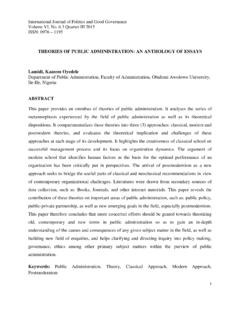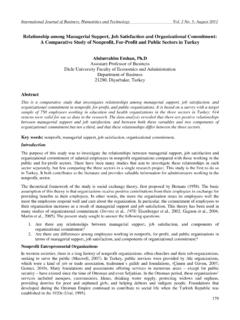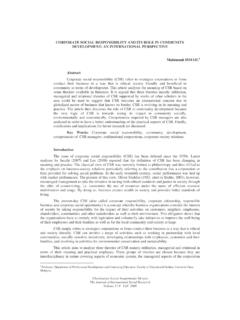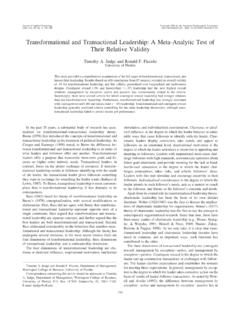Transcription of Cover-Relationships between media and audiences
1 Sonia Livingstone Relationships between media and audiences : prospects for audience reception studies Book section Original citation: Originally published in Liebes, T and Curran, J. media , ritual and identity: essays in honor of Elihu Katz. London, UK : Routledge, 1998, pp. 237-255. 1998 Sonia Livingstone This version available at: Available in LSE Research Online: October 2008. LSE has developed LSE Research Online so that users may access research output of the School. Copyright and Moral Rights for the papers on this site are retained by the individual authors and/or other copyright owners.
2 Users may download and/or print one copy of any article(s) in LSE Research Online to facilitate their private study or for non-commercial research. You may not engage in further distribution of the material or use it for any profit-making activities or any commercial gain. You may freely distribute the URL ( ) of the LSE. Research Online website. This document is the author's submitted version of the book section. There may be differences between this version and the published version. You are advised to consult the publisher's version if you wish to cite from it.
3 Relationships between media and audiences : Prospects for audience reception studies 1. Sonia Livingstone London School of Economics and Political Science Houghton Street, London WC2A 2AE. United Kingdom Tel +44 171 955 7710/4 Fax +44 171 955 7565. Email Original Citation: Livingstone, S. (1998) Relationships between media and audiences : Prospects for future audience reception studies. In Liebes, T., and Curran, J. (Eds.), media , Ritual and Identity: Essays in Honor of Elihu Katz. London: Routledge. 1. An earlier version of this paper was presented to The media and the public: Rethinking the part played by the people in the flow of mass communications.
4 International Symposium in honor of Elihu Katz, Jerusalem, May 1996, and to the 46th International Communication Association Annual Conference, Chicago, 1996. I am grateful to the many colleagues who have commented on earlier versions of this paper. 1. The problems and possibilities for audience research This paper sets out to ask 'what next' for audience research. ' audience reception analysis', 'reception studies' or ' audience ethnography' emerged and developed, with considerable success, from a convergence of hitherto opposed research traditions during the 1980s (Corner, 1991; Livingstone, 1995).
5 audience studies currently face a paradox in which many interesting papers, especially those reporting empirical observations, are being published, while simultaneously there exists a body of criticisms which have largely gone unanswered. This then seems an appropriate moment to consider the achievements, problems and future direction of audience reception studies. In brief, I will argue that the construction of a research 'canon' has generated this apparent paradox. The success of the canon has undoubtedly stimulated a range of interesting and innovative empirical studies.
6 Yet it has also provided a legitimacy which permits researchers to bypass the criticisms by providing a template for audience research which does not require any more formalised theorisation or research agenda. Thus, the critiques go unanswered partly because the field's failings can neither be set against its aims or used to develop theory further. Yet by going beyond the canon, audience research can better address the critiques, thereby opening up audience studies to a more diverse set of questions which would move research towards a more explicit theory of audiences and hence towards more productive relations between audience studies and other domains of media and communications.
7 The convergence of multiple research traditions audience reception studies focus on the interpretative relation between audience and medium, where this relation is understood within a broadly ethnographic context. It would be inappropriate to identify any unitary origin for reception studies, and even dating their starting point depends on how one identifies the key precedents (Allor, 1988; Jensen and Rosengren, 1990). I would identify the following six trajectories towards reception studies which converged during the late 1970s as part of a broader movement towards interdisciplinarity in the social sciences.
8 Each of these six routes may be characterised in brief by the advocacy of a central argument or core concept. One of these focused on the processes of producing and reproducing culture. Thus when noting in 1980 the beginning of 'a new and exciting phase in so-called audience research' ( ), Hall introduced the paired concepts of encoding and decoding to integrate text and audience studies. Hall welcomed the opportunity for cultural studies to examine empirically how 'the degrees of "understanding" and "misunderstanding" in the communicative exchange -- depend on the degrees of symmetry/asymmetry (relations of equivalence) established between the positions of the "personifications", encoder/producer and decoder/receiver' (1980, ).
9 Simultaneously, researchers in a domain traditionally opposed to cultural studies, that of uses and gratifications, saw the new focus on audience interpretation as setting the scene for them 'to build the bridge we have been hoping might arise between gratifications studies and cultural studies' (Katz, 1979, ). The rationale here was to account for the selective responses of audiences in the face of media excess, with the key concept being the active audience . Thus these researchers wanted to open up a broader conception of what audiences might do with texts, in order to allow for the ritual uses of communications as well as the transmission of media contents from producers to audiences (Carey, 1975; see Dayan and Katz, 1992; see also DAYAN and CAREY, THIS VOLUME).
10 A third route to reception studies drew upon moves within critical mass communications 2. research to shift attention away from an exclusive focus on the ideological and institutional determinants of media texts towards including a role for a possibly active, but hitherto 'disappearing', audience (Fejes, 1984). This resulted in a focus on the resistant audience , as part of the questioning of such hegemonic theories as the dominant ideology thesis (Abercrombie, et al, 1980), the cultural imperialism thesis (Hallin, 1996) and the political economy approach (Murdock, 1989).



